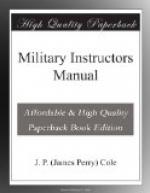FREEZING AND FROSTBITES.—Use ice water and snow to start with. Keep the patient cool until he is thawed out. Massage and gradually work up to a warmer temperature.
FRACTURES are of three kinds; simple, compound and comminuted.
Simple: Bones do not penetrate
the skin (may be single or double).
Compound: Bones penetrate the
skin and cause infection.
Comminuted: Bone is shattered.
Indications of a fracture are: Pain, redness, swelling and mobility where it ought not to be.
TREATMENT.—Find out the kind of fracture. Paint the wound and put on first aid packet; replace the clothes and splint the break. Splints should not be too long so as to cause any friction or annoyance to the patient. They may be made out of any available material, such as rifle, bayonet, shingle, piece of board, scabbard, etc. Bind them firmly but not too tightly.
ARTIFICIAL RESPIRATION.—This subject is worthy of more treatment than it can be accorded here. Any text on first aid will explain thoroughly the Schaefer method, which is now the standard method in the army. Points to be remembered in this method are; remove foreign articles from the mouth; curl the little finger over the 12th rib; avoid the pelvic bones; hold the arms straight and apply the pressure by means of the whole body brought forward; take care not to break a rib; do not give up too soon.
TRENCH FOOT.—This is due to long standing with legs and feet in wet clothes. There are three types:
Mild: Symptoms are numbness
and a slight swelling.
Medium: Additional symptom
of a bluing of the leg; also large
blisters.
Severe: Gangrene sets in.
Tight clothes help to bring on these things. Keep the shoes, socks and breeches loose; keep the clothes dry; furnish the men with hot food in the trenches and so keep up the circulation. Do not use grease. Trench foot can be avoided by proper treatment, and punishment should follow upon its contraction.
CHAPTER 11.
Signaling.
This chapter proposes to cover a large amount of ground in a small compass; hence treatment must be brief. A more liberal treatment will be found at different sources; here a few suggestions and hints will be given.
SEMAPHORE.—Time spent, 61 hours: 6 sessions 1/2 hours, 1 session 1 hour, 1 conference 2 hours. It is easy to say “just learn the semaphore,” but to learn it quickly and well is another matter. A few suggestions as to the methods followed by others will usually prove helpful. Learn the semaphore by what may be called the “cycle” method, i.e., teach and illustrate how the successive letters are formed by moving the arm or arms around the body in a clockwise direction through successive stages. There are a few exceptions to the rule as will be pointed out; but they only serve as a few landmarks and help to fix the whole matter more firmly in mind.




